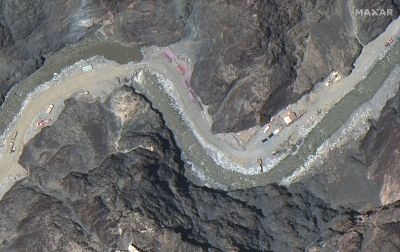Satellite images show buildup on India-China LAC

Beijing: Satellite imagery of the disputed India-China frontier high in the Karakoram mountains shows that both countries have stepped up construction activity on their side. Tensions have soared since a deadly clash in the area left 20 Indian soldiers dead.
Images released this week by Maxar, a Colorado-based satellite imagery company, show new construction activity along the Galwan Valley even as military commanders of both countries said they agreed to disengage from the standoff.
The images appeared to show that India had built a wall on its side and the Chinese expanded an outpost at the end of a long road connected to Chinese military bases way from the disputed border, experts said.
 This combination of satellite images taken on May 22, 2020 (left) and June 23 Maxar Technologies shows construction in the Galwan river valley near the Line of Actual Control between India and China. (AP)China has said that India changed the status quo last August when it split the state of Jammu & Kashmir into two Union territories _ the territory of Jammu & Kashmir and the territory of Ladakh, parts of which are contested by China.
This combination of satellite images taken on May 22, 2020 (left) and June 23 Maxar Technologies shows construction in the Galwan river valley near the Line of Actual Control between India and China. (AP)China has said that India changed the status quo last August when it split the state of Jammu & Kashmir into two Union territories _ the territory of Jammu & Kashmir and the territory of Ladakh, parts of which are contested by China.
New maps released by India following that decision last August drew criticism from Beijing because they showed Aksai Chin, an area occupied by Pakistan and subsequently ceded to China, as part of Ladakh.
Indian officials said the standoff that culminated in this month's deadly clash in the Galwan Valley, part of a remote stretch of the 3,380-kmLine of Actual Control (LAC), established following the 1962 war, began in early May when large contingents of Chinese soldiers entered deep inside Indian-controlled territory at three places in Ladakh, erecting tents.
After a few skirmishes in May, Indian and Chinese commanders met June 6 to hash out an agreement that would reduce tensions.
The two sides agreed to build observation posts on either side of the mouth of the Galwan River, China's ambassador to India, Sun Weidong, told PTI news agency on Tuesday.
India’s Ministry of External Affairs spokesperson Anurag Srivastava said that during the June 6 meeting "both sides had agreed to respect and abide by the LAC and not undertake any activity to alter the status quo,'' but did not address whether they had agreed to observation posts.
Around midnight on June 15, soldiers attacked each other with rocks, clubs and their fists in the Galwan Valley, the deadliest violence between the two countries in 45 years.
A sequence of Maxar images of the river bend where the clash occurred in the weeks before and after the clash showed that construction had expanded up the Galwan Valley towards the Line of Actual Control from Chinese bases, Maxar vice-president Steve Wood said.
Wood said that since May 22, satellite images showed “convoy after convoy of heavy trucks, diggers, bulldozers and some military armored equipment'' rolling down the Galwan Valley toward the disputed border.
 This handout satellite image taken on May 22, 2020, released by Maxar Technologies shows a China's People's Liberation Army (PLA) base in Kongka Pass bordering India and China. China and India have increased activity on the Line of Actual Control in recent weeks. (AP)Before and after the clash, China was moving construction equipment, soldiers and military hardware toward the LAC, said Chris Biggers, senior analyst at the geospatial intelligence company HawkEye 360.
This handout satellite image taken on May 22, 2020, released by Maxar Technologies shows a China's People's Liberation Army (PLA) base in Kongka Pass bordering India and China. China and India have increased activity on the Line of Actual Control in recent weeks. (AP)Before and after the clash, China was moving construction equipment, soldiers and military hardware toward the LAC, said Chris Biggers, senior analyst at the geospatial intelligence company HawkEye 360.
“The Chinese were obviously pushing toward the junction and what they perceive as their claim line. They have now built a post and a track reinforcing their claim, thus changing the status quo in the area,'' he said.
At that junction, the Galwan River turns west towards an important supply route for a key Indian airfield. Biggers said that satellite imagery shows that India has built a stone wall there facing the new Chinese post, with a layered set of barriers draped in camouflage netting and tarps that “could also function as fighting positions.''
“We also see quite a bit of activity on the road, with trucks moving in both directions as well as troops marching in formation along the new track,'' Biggers said.

